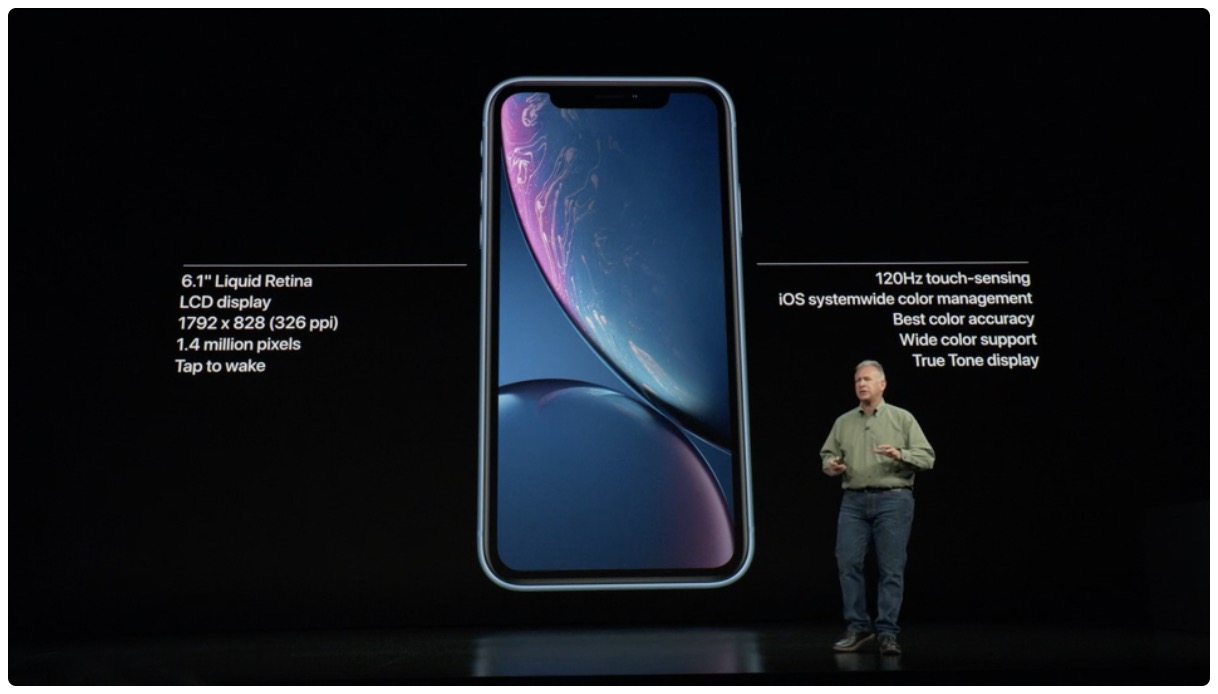
Apple’s iPhone XR brings all of the same features as the pricier iPhone XS series sans a few notable exceptions like its lower-resolution display based on LCD rather than OLED technology. Turns out that some techies are upset that, at 6.1 inches, the iPhone XR screen is not full HD so downscaling inevitably occurs when watching Full HD (1920×1080) video.
Apple’s SVP of Worldwide Marketing, Phil Schiller, sat down with Engadget’s Chris Velazco to talk the new iPhone resolutions and more. TLDR: he thinks the average user couldn’t care less about the lower-resolution iPhone XR display because it still deserves that Retina moniker.
Phil’s comments
To him, complaints about the iPhone XR screen are a case of what’s on paper not doing justice to reality. “I think the only way to judge a display is to look at it. If you can’t see the pixels, at some point the numbers don’t mean anything,” he said. “They’re fairly arbitrary.”
Asked whether the screen was to blame for the XR’s staggered release, the Apple executive simply responded by saying, “This is when it’s ready.”
Phil touched on several other topics, too.
Ask to comment what the “R” in iPhone XR stands for and what the “S” in iPhone XS, 6S, 5S and so forth means, Phil, a longtime fan of Porsches and Audis, said: “I love cars and things that go fast, and R and S are both letters used to denote sport cars that are really extra special.”

In other words, the “R” in iPhone XR and the ”S” in S-iPhones are both meant to indicate speed. Apple actually acknowledged as much back when the iPhone 3GS released, its first iPhone that introduced the confusing S-branding. Apple wanted something easy and powerful for customers to familiarize themselves with so that would-be buyers didn’t think iPhones released in S-years were inferior upgrades (and in doing so, Apple’s painted itself into a naming corner).
Be sure to read the full interview over at Engadget.
Discerning the pixels
Even though iPhone XR sports a bigger display at 6.1 inches than the 5.8-inch iPhone XS model, the resolution of that LCD screen is lower at 1792×828 versus the iPhone XS’s 2436×1125 OLED panel. Not only that but the iPhone XS features sharper images because it manages to squeeze more pixels per inch (458) than the iPhone XR screen at 326 ppi.
Being one of a handful of people actually to use the #iPhoneXR I need to respond to the most common comment on YouTube
It’s true that the screen is not quite 1080p, but anyone that tells you that notice the difference is lying
The pixel density is great, don’t worry about it
— Tyler Stalman (@stalman) October 21, 2018
Here’s the screen resolution and pixel density (ppi) comparison:
- iPhone XS: 2436×1125, 458ppi
- iPhone XS Max: 2688×1242, 458ppi
- iPhone XR: 1792×828, 326ppi
Apple defines a smartphone Retina screen as having at least 320ppi.
This is the threshold at which the human eye is unable to make out the individual pixels so jagged object edges become smooth continuous lines while fonts appear like in print.
Retina iPhones have typically started at 326ppi. He’s right that the typical human eye cannot resolve the pixels as we go beyond 320ppi. However, even though we cannot discern the pixels at 320+ ppi, the more there are per inch the sharper onscreen images get.
Another benefit to having more pixels at your disposal: fonts look great at the smallest sizes while content such as photos and videos can convey more information per square inch of screen real estate (meaning less zooming to make out details in apps like Photos and Safari).
Is the iPhone XR display a deal breaker, do you think?
Are average buyers who are predominantly attracted to the iPhone X price even going to care about, or notice that they’re using a lower-resolution Retina display?
Let us know by leaving a comment below.